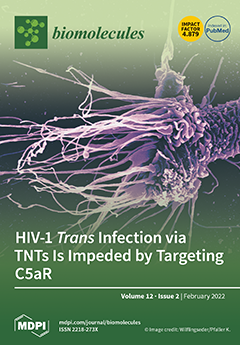Nonadjacent immune cells communicate through a complex network of tunneling nanotubes (TNTs). TNTs can be hijacked by HIV-1, allowing it to spread between connected cells. Dendritic cells (DCs) are among the first cells to encounter HIV-1 at mucosal sites, but they are usually
[...] Read more.
Nonadjacent immune cells communicate through a complex network of tunneling nanotubes (TNTs). TNTs can be hijacked by HIV-1, allowing it to spread between connected cells. Dendritic cells (DCs) are among the first cells to encounter HIV-1 at mucosal sites, but they are usually efficiently infected only at low levels. However, HIV-1 was demonstrated to productively infect DCs when the virus was complement-opsonized (HIV-C). Such HIV-C-exposed DCs mediated an improved antiviral and T-cell stimulatory capacity. The role of TNTs in combination with complement in enhancing DC infection with HIV-C remains to be addressed. To this aim, we evaluated TNT formation on the surface of DCs or DC/CD4
+ T-cell co-cultures incubated with non- or complement-opsonized HIV-1 (HIV, HIV-C) and the role of TNTs or locally produced complement in the infection process using either two different TNT or anaphylatoxin receptor antagonists. We found that HIV-C significantly increased the formation of TNTs between DCs or DC/CD4
+ T-cell co-cultures compared to HIV-exposed DCs or co-cultures. While augmented TNT formation in DCs promoted productive infection, as was previously observed, a significant reduction in productive infection was observed in DC/CD4
+ T-cell co-cultures, indicating antiviral activity in this setting. As expected, TNT inhibitors significantly decreased infection of HIV-C-loaded-DCs as well as HIV- and HIV-C-infected-DC/CD4
+ T-cell co-cultures. Moreover, antagonizing C5aR significantly inhibited TNT formation in DCs as well as DC/CD4
+ T-cell co-cultures and lowered the already decreased productive infection in co-cultures. Thus, local complement mobilization via DC stimulation of complement receptors plays a pivotal role in TNT formation, and our findings herein might offer an exciting opportunity for novel therapeutic approaches to inhibit
trans infection via C5aR targeting.
Full article






